Pork and vegetable stew is a scrumptious one-pot meal featuring tender pork and assorted vegetables brought together with a tomato based sauce. It is hearty, filling, and full of nutrition, perfect for your Sunday dinner or meal prep.
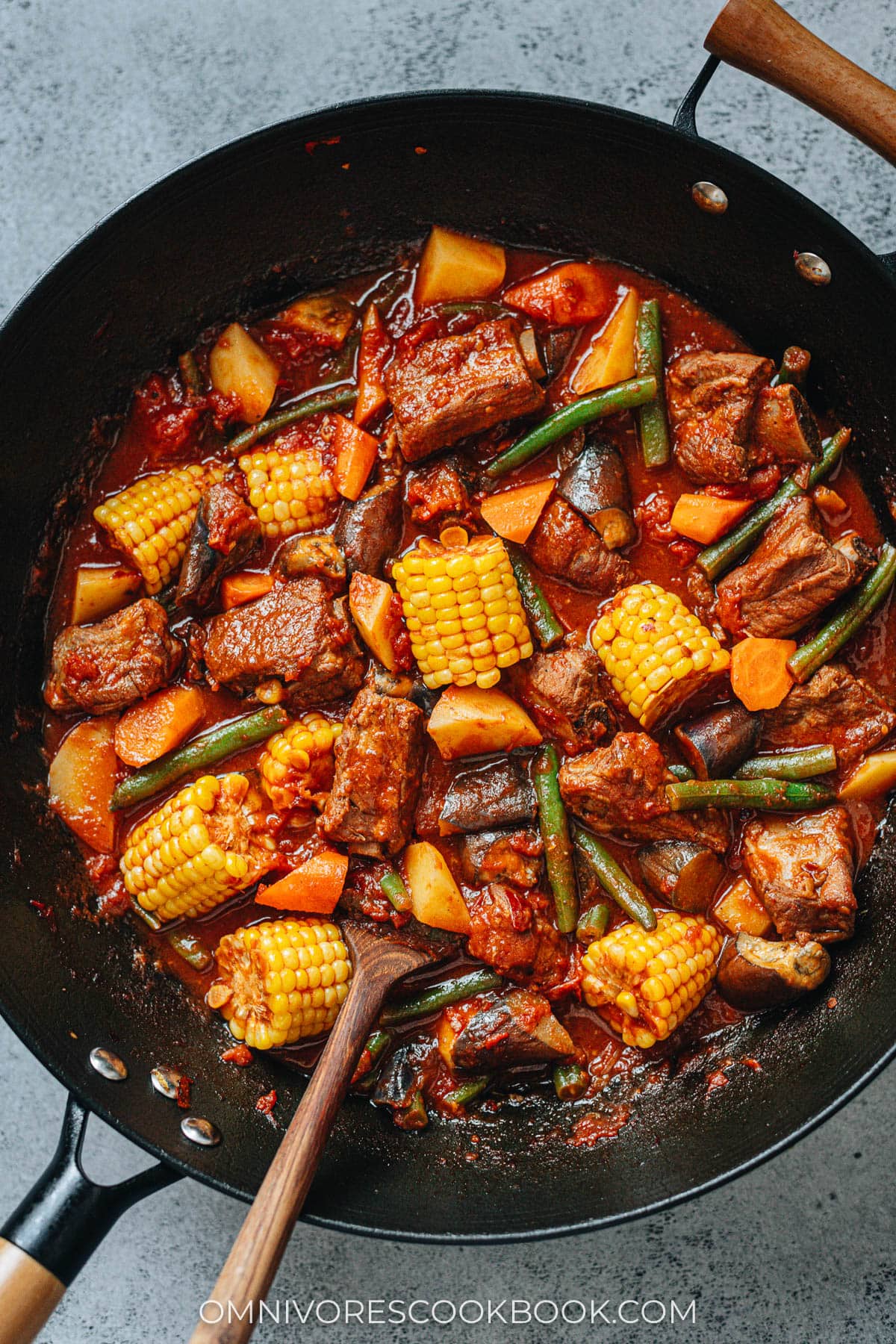
An introduction to Chinese pork and vegetable stew
Pork and vegetable stew, or Luan Dun (Stew randomly) is a traditional northeastern Chinese stew known for its hearty, rustic nature. “Luan Dun” translates to “mixed stew” or “randomly stewed,” which highlights its key feature—an assortment of ingredients thrown together and slowly stewed.
Luan Dun represents the harvest. The dish typically includes pork and various vegetables such as potatoes, carrots, cabbage, eggplant, tomatoes, and green beans. The ingredients can vary based on what you have on hand, but the dish is always hearty and filling.
All ingredients are stewed together in a single pot with a savory broth. The seasonings are simple, often including soy sauce, star anise, and scallions, allowing the natural flavor of the ingredients to shine.
The Dongbei region covers the three northeastern provinces of China that border Russia. Food there always comes in big portions. The cooking emphasizes simplicity, designed to be warm, nutritious, and packed with calories to sustain people during the harsh winters.
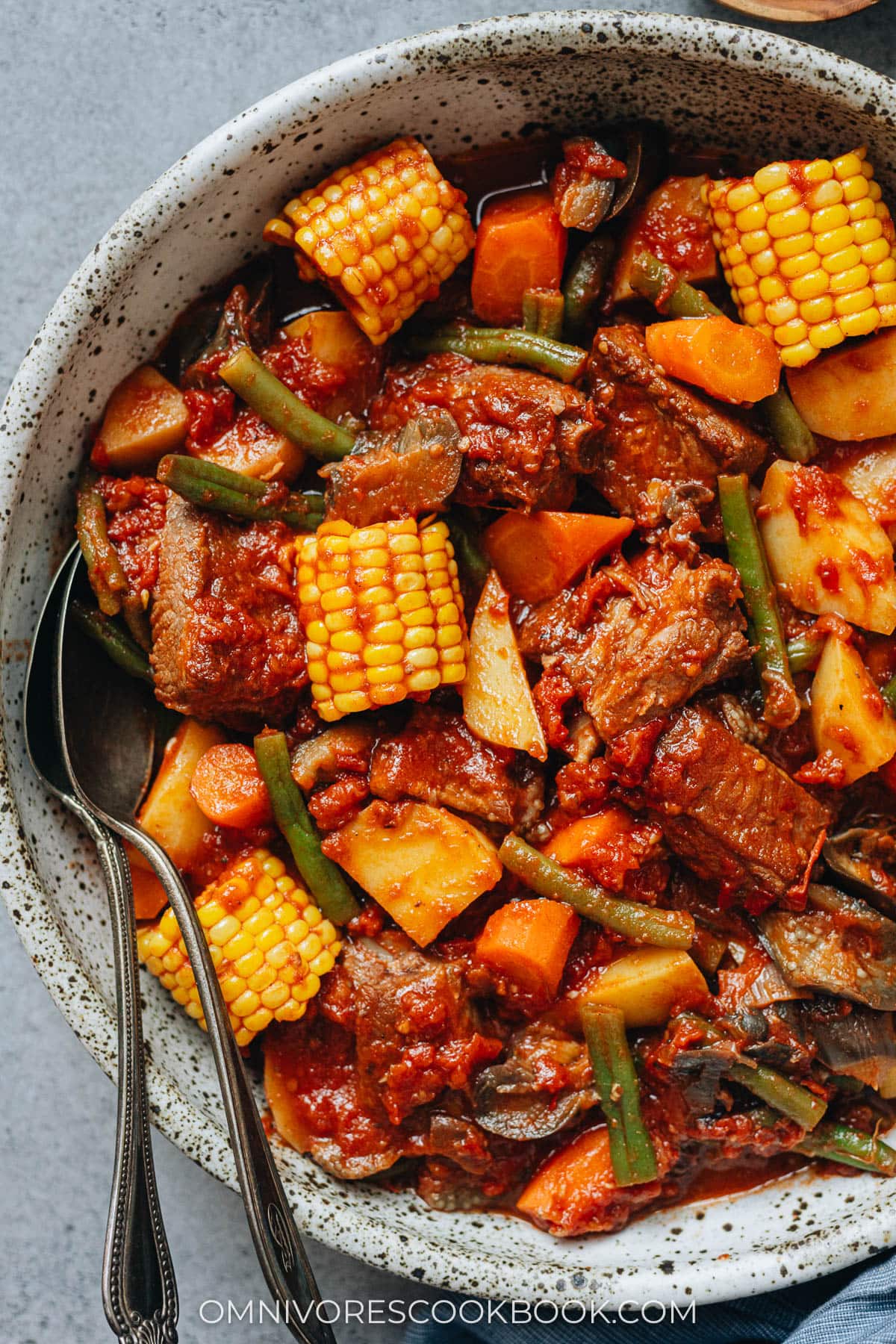
Pork and vegetable stew ingredients
Pork and vegetable stew is a comforting, homestyle dish often made in large portions to serve to family and friends. Each household has its own version with slight variations based on personal taste and ingredient availability.
My recipe is a slightly more elevated version than the typical homestyle version, based on the dish I’ve had countless times in restaurants in Beijing.
Which cut of pork to use
Any pork cut that is suitable for stew can be used in the pork and vegetable stew. In China, pork ribs and pork belly are the most popular options, because both create a delicious broth. Other cuts such as pork shoulder (butt) and pork shank work very well too.
I used short pork ribs, which you can find in most Chinese markets. The short ribs take less time to cook and are sized similarly with the vegetables. But if you can only find regular slabs of ribs, you can use baby back ribs and cut them into single riblets.
The seasonings
There are many ways to season pork and vegetable stew, most of them soy sauce based.
My recipes uses:
- Aromatics: scallion and garlic
- Spices: star anise and cinnamon stick for a warm taste
- Soy sauce and sugar for the base
- Chicken broth
- Doubanjiang: for a spicy kick and fermented umami
Doubanjiang is a key ingredient in Mapo Tofu. It is a salty spicy fermented paste that is full of umami. I like to use it in my pork and vegetable stew because it adds so much flavor to the dish.
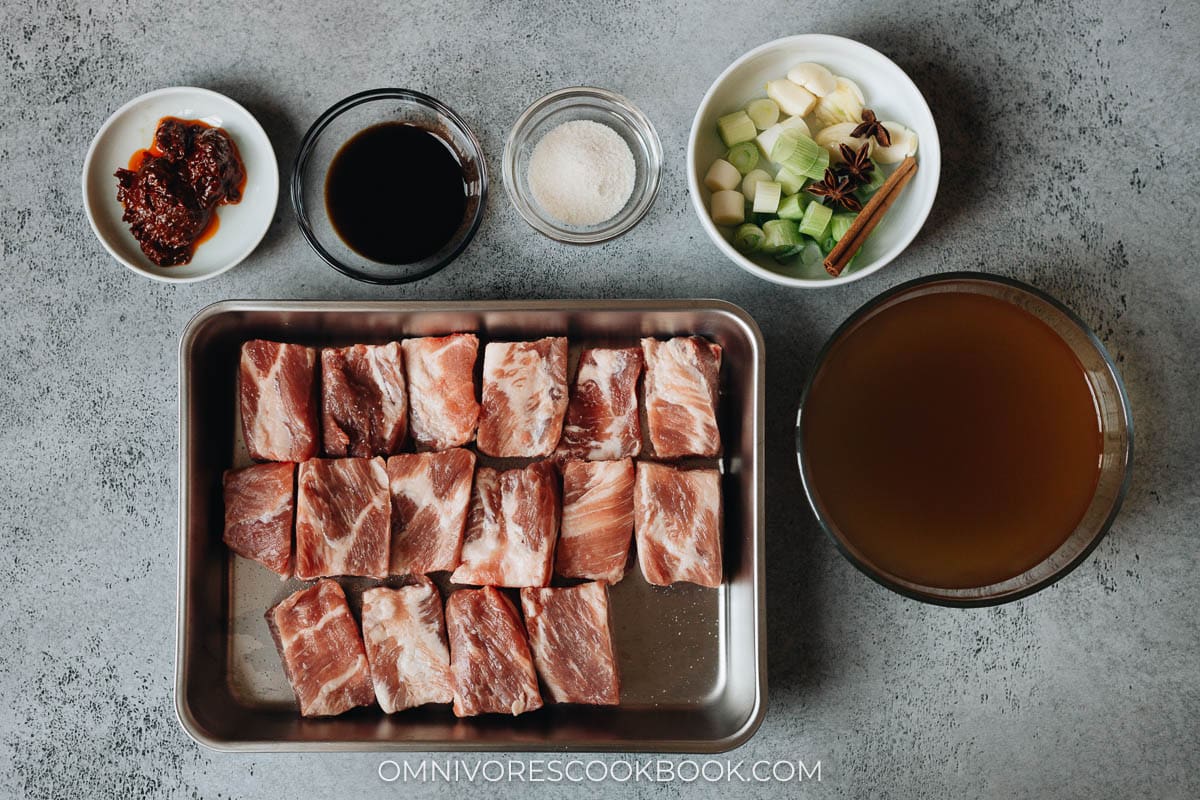
How to make the dish not spicy?
If you prefer not to use Doubanjiang, you can experiment with oyster sauce, Tian Mian Jiang (Sweet Bean Sauce)or more soy sauce.
The vegetables
There are so many vegetables you can add to your pork and vegetable stew. I used some of the most popular ones in my recipe, including:
- Potato
- Carrot
- Green beans
- Corn on the cob
- Eggplant
- Tomato
Most pork and vegetable stews use cut up fresh tomatoes as part of the veggie section. But in this recipe I chose to use canned tomato as a part of the base. I did this to create a more flavorful base without using too much salt.
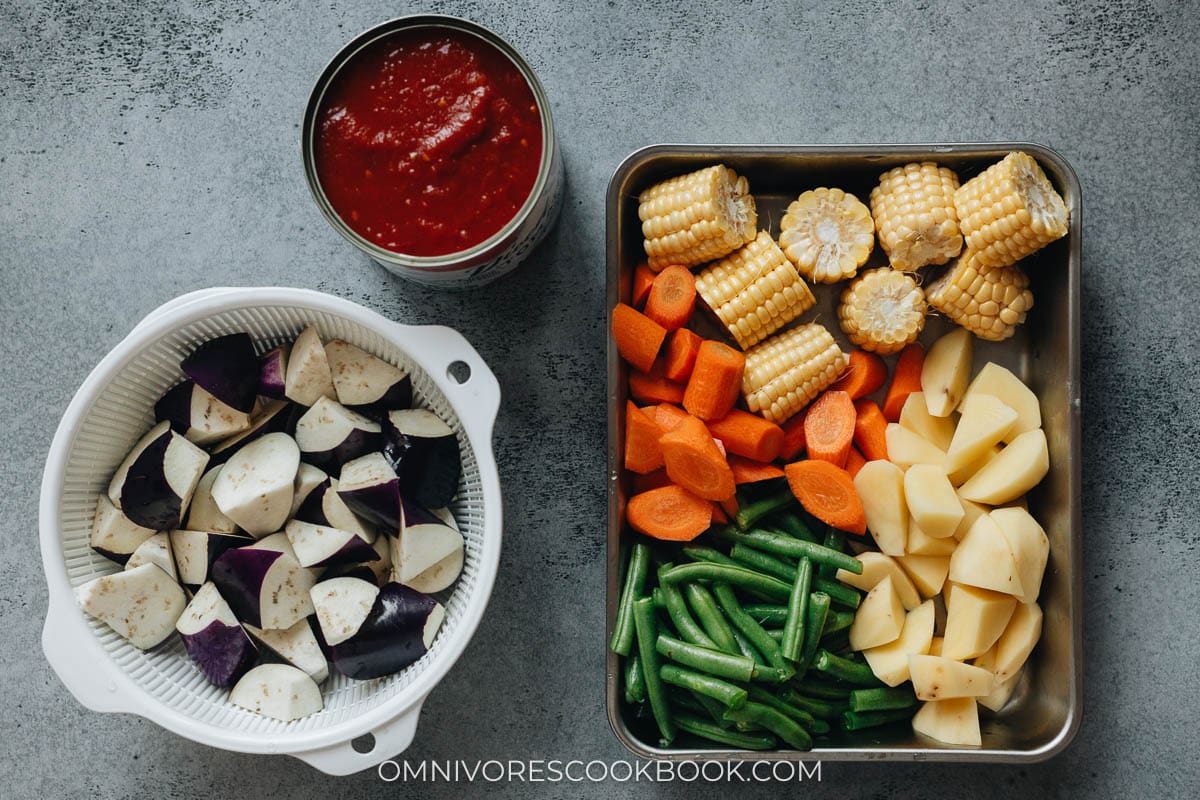
Other vegetable alternatives
I also recommend using napa cabbage, pumpkin or other winter squash, mushrooms, and cabbage. These harder vegetables are great because they will hold their shape during cooking and won’t overcook easily. If you decide to use tender vegetables like bok choy, you should add them during the last 5 minutes of cooking to prevent overcooking.
How to make pork and vegetable stew
Making pork and vegetable stew requires a bit of time but it’s quite hands-off once you start cooking.
First, brown the pork ribs.
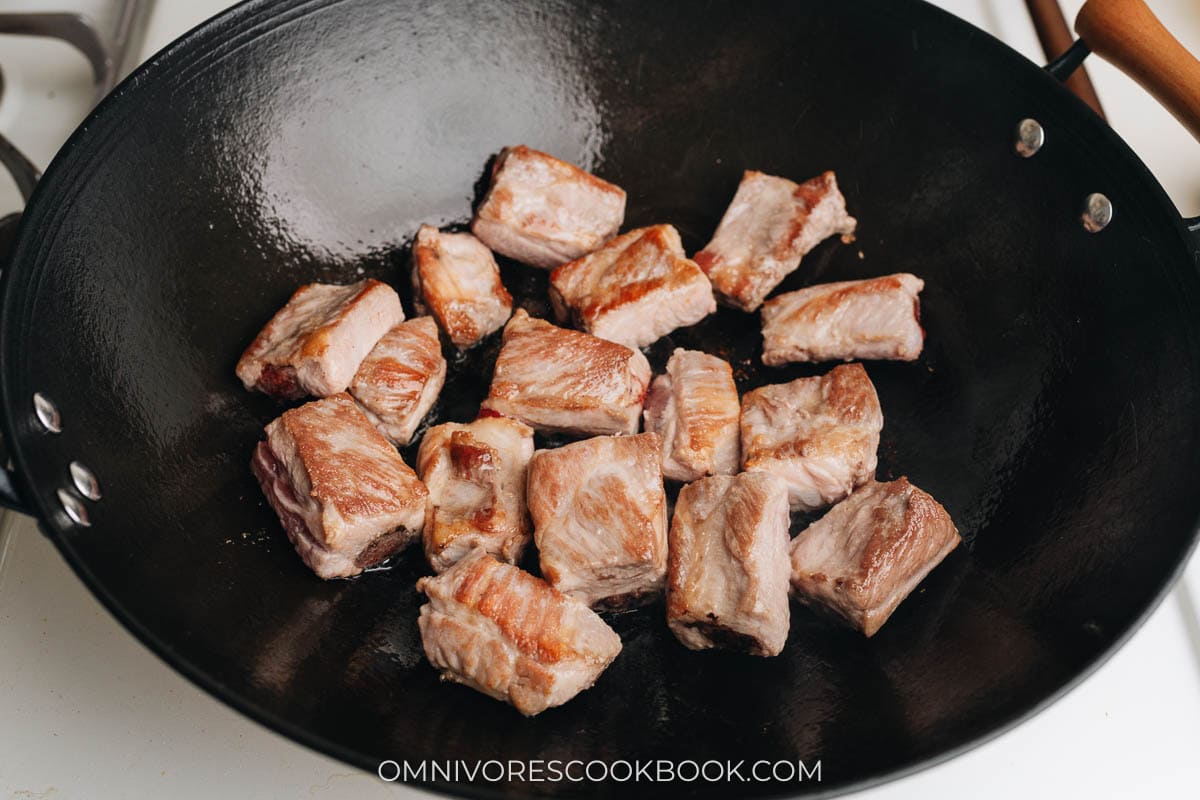
Then add the aromatics and spices. Stir and cook to release fragrance. Then add the Doubanjiang and gently toast it. Pour in Shaoxing wine to deglaze the pan.
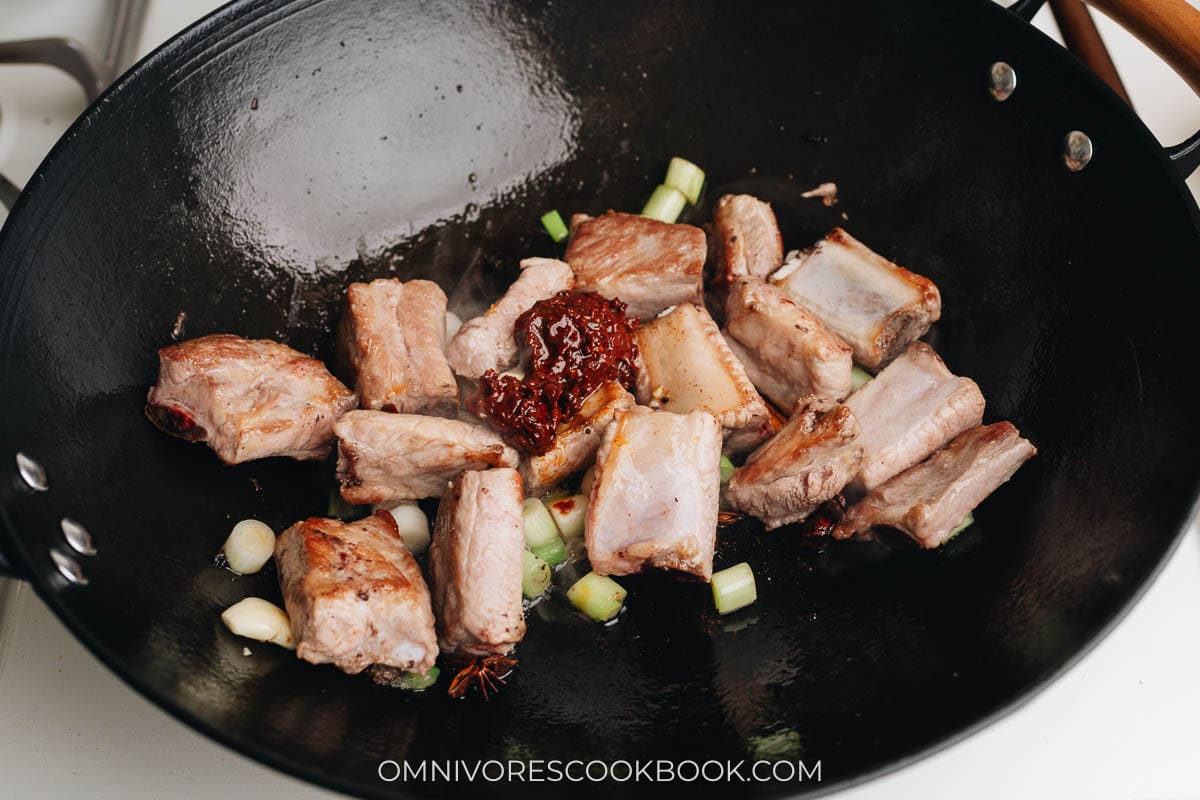
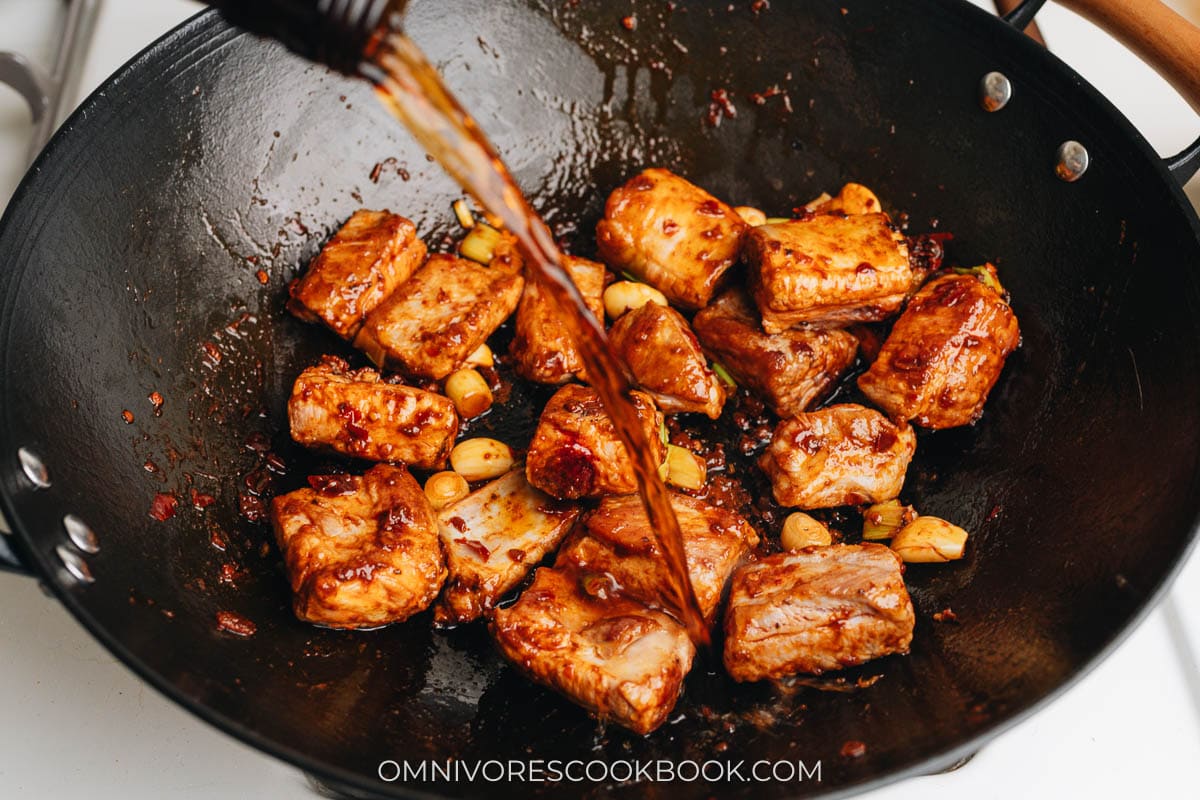
Add the chicken broth, soy sauce and sugar. Bring to a simmer then cook covered until pork is tender, 1 hour or so.
Then add all the vegetables and the canned tomato. Let steam, covered, for 5 minutes. At this point, it will look like the vegetables are not covered in the broth. But no worries. After 5 minutes, the vegetables will release a lot of juice and surmerge all the ingredients.
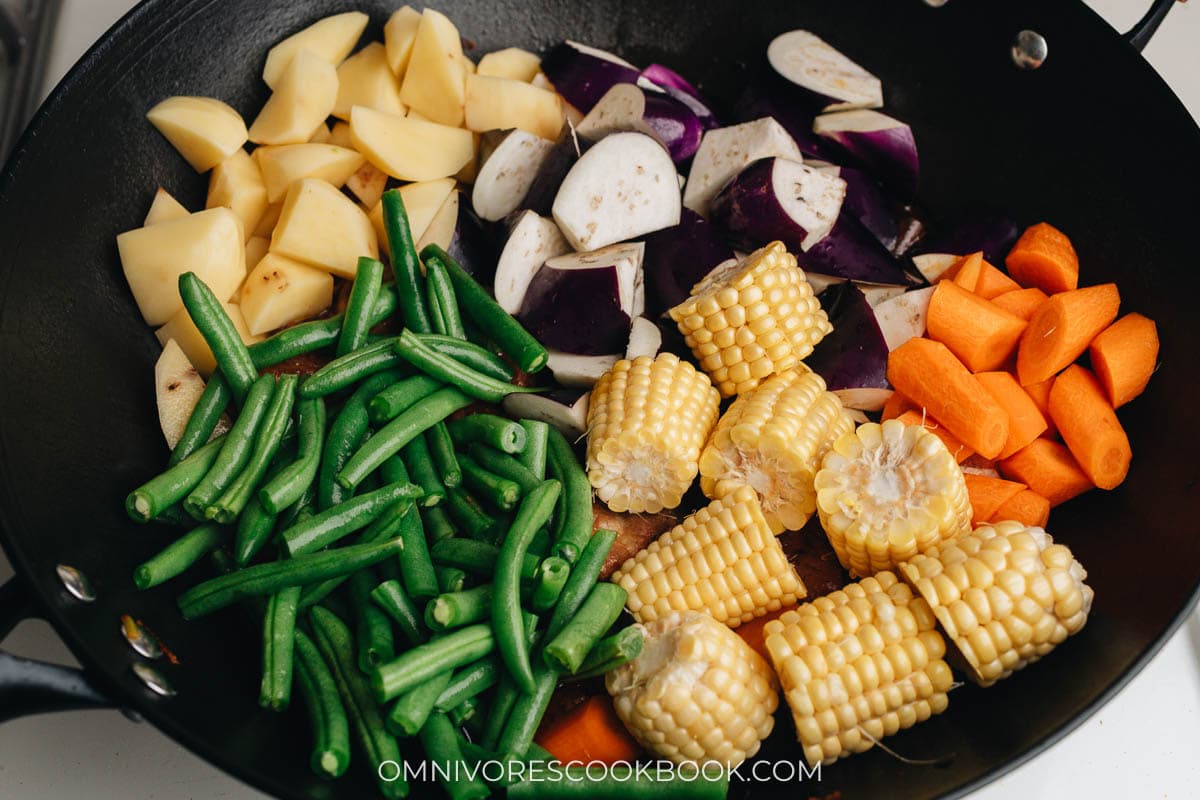
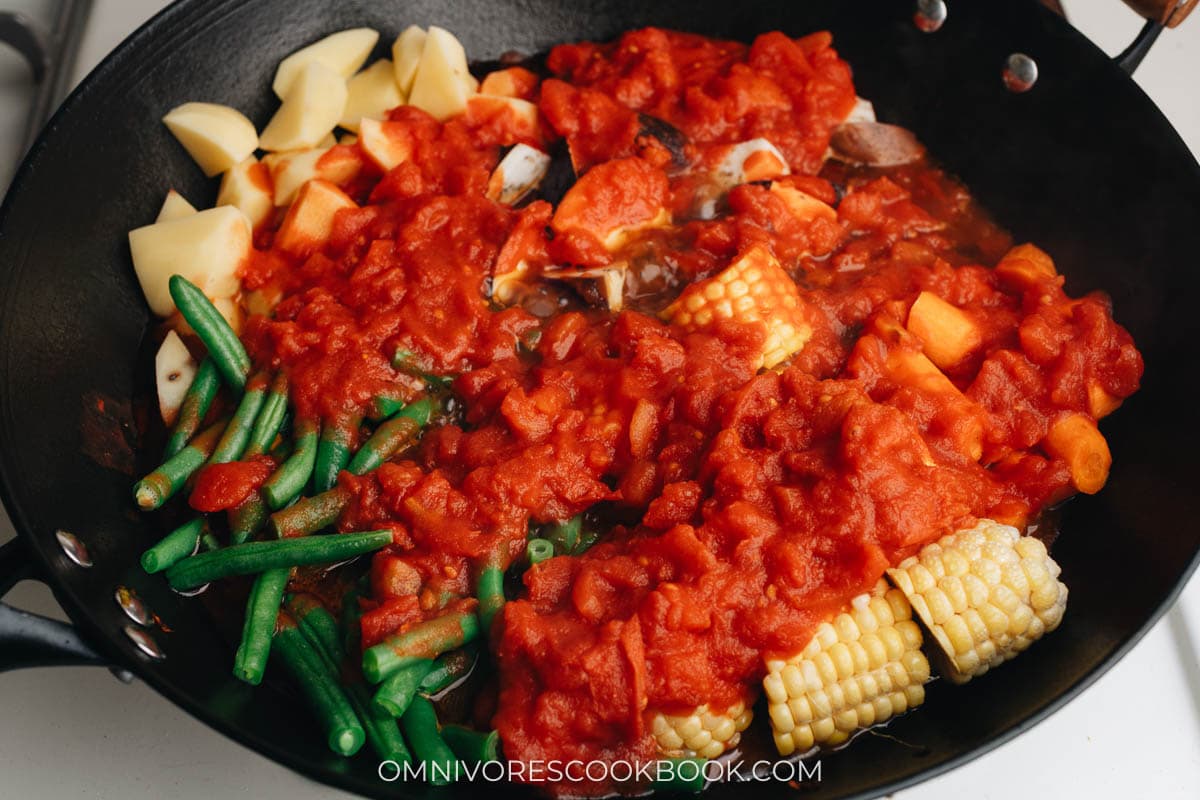
After 5 minutes, uncover the pan and continue cooking until the vegetables turn soft, 15 to 20 minutes.
Once done, the broth will be reduced and thickened a bit, the pork and vegetables very tender and flavorful. Now you can simply top them on rice and enjoy your hearty meal!
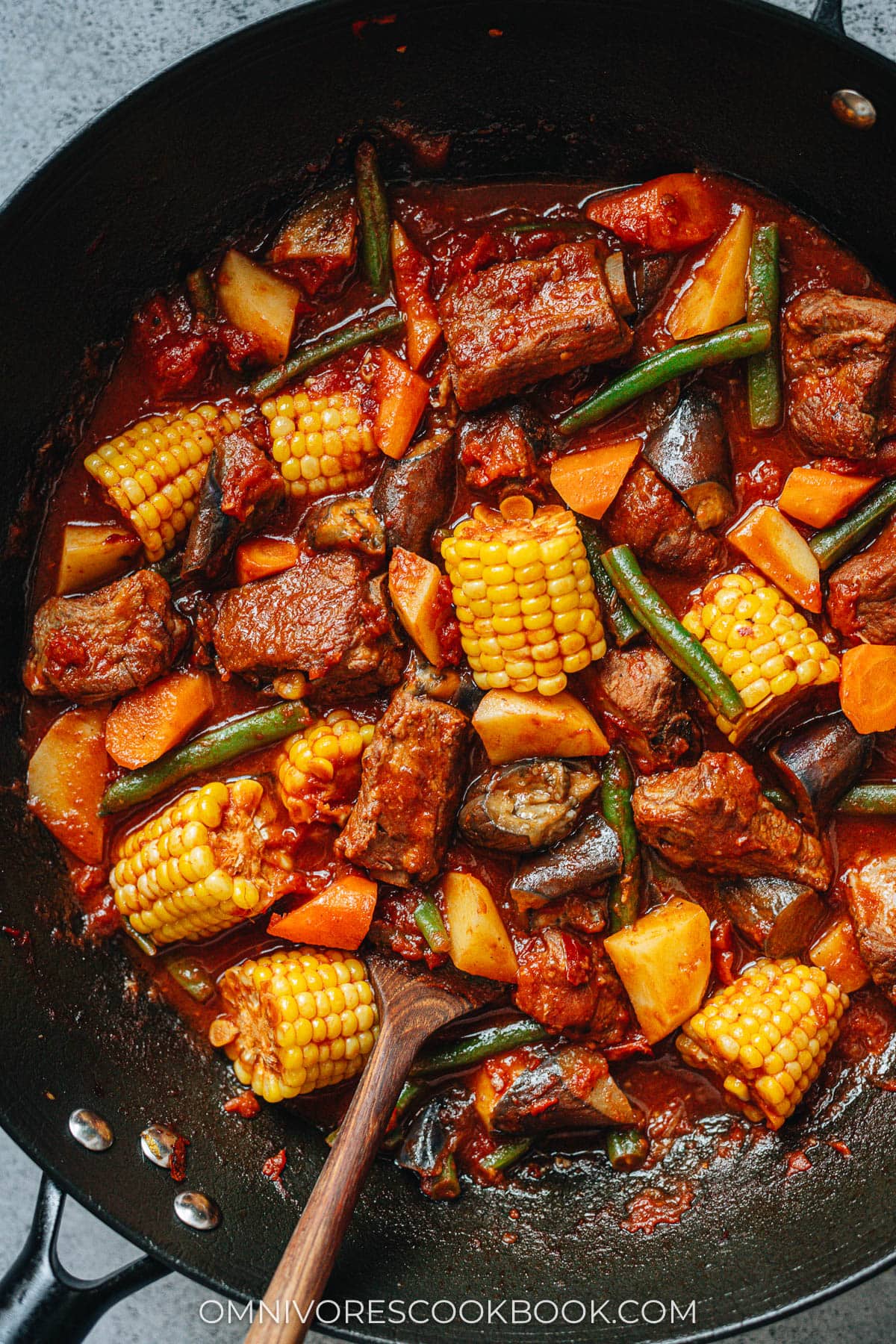
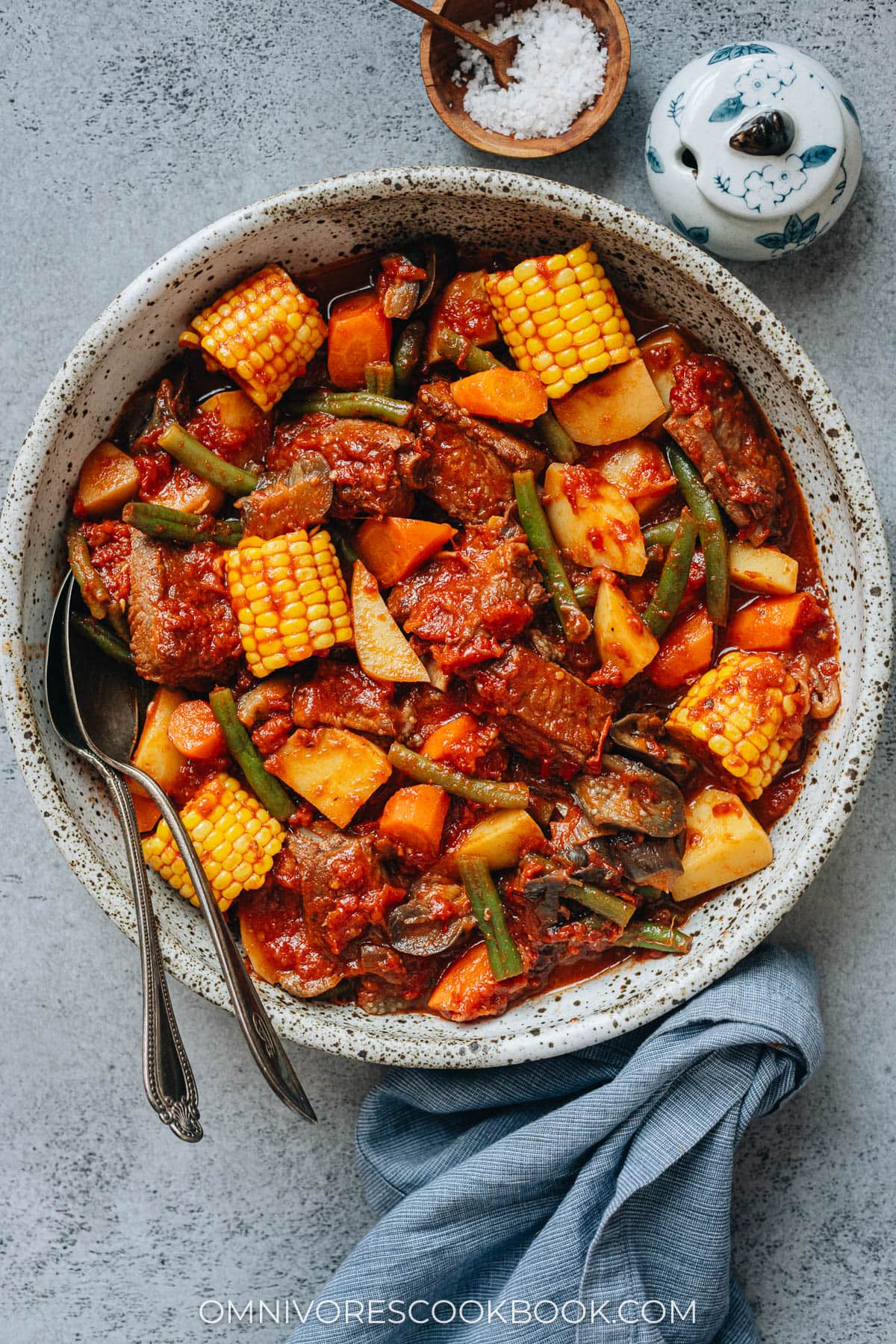
What is the best cookware for pork and vegetable stew?
I used a 14.5” flat bottom wok for this recipe. It’s my favorite pan for this type of dish because:
- It’s very easy to brown meat in it without sticking.
- You can use less liquid to cover all the ingredients due to the shape of the pan.
- It is easier to stir and flip the ingredients.
If a large wok is not available, you can use a large cast iron pot. It is a great alternative to the wok and it creates a great result too.
More Northern Chinese dishes
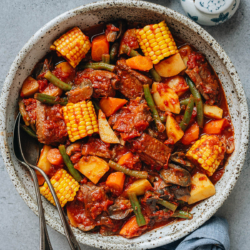
Pork and Vegetable Stew (乱炖)
Pork and vegetable stew is a scrumptious one-pot meal featuring tender pork and assorted vegetables brought together with a tomato based sauce. It is hearty, filling, and full of nutrition, perfect for your Sunday dinner or meal prep.
Ingredients
- 1 to 1.5 lb (450 to 600 g) pork ribs (or pork shoulder, or pork belly) (*Footnote 1)
- 1/4 teaspoon salt
- 1 tablespoon peanut oil (or vegetable oil)
- 2 green onions sliced to 1/2” (1 cm) pieces
- 4 cloves garlic smashed
- 1 whole star anise pod
- 1 cinnamon stick
- 2 tablespoons doubanjiang
- 2 tablespoons Shaoxing wine (Optional)
- 2 cups chicken broth (or water)
- 2 tablespoons I am willow
- 1 tablespoon sugar
- 2 Chinese eggplant chopped to bite-sized pieces (or 1 regular eggplant) (about 10 oz / 300 g)
- 2 yukon potatoes chopped to bite-sized pieces (about 1/2 lb / 225 g)
- 1/2 lb (225 g) green beans tough ends removed and halved crosswise
- 2 big carrots chopped to bite-size pieces (about 1/2 lb / 225 g)
- 2 ears corn on the cob cut to 2” (5-cm) long pieces
- 1 can (28-oz.) tomatoes diced
Instructions
-
Sprinkle salt evenly on both sides of pork ribs.
-
Heat 1 tablespoon of oil in a large wok (or a 5-qt dutch oven, or a heavy duty pot) over medium heat until hot. Add pork ribs. Brown both sides until golden.
-
Add the green onion white part, garlic, star anise, and cinnamon stick. Cook and stir until very fragrant, 2 to 3 minutes.
-
Add doubanjiang. Cook and stir until the ingredients are covered evenly, and you can smell a pungent aroma, about 1 minute.
-
Pour in the Shaoxing wine and deglaze using a spatula, scraping off any brown bits from the bottom.
-
Pour in the chicken broth. Add the soy sauce and sugar. Return the pork ribs to the pot. Turn to medium-high heat and cook until brought to a boil. Cover, turn to medium-low or low heat, simmer for 1 hour or so, until the ribs start to turn tender.
-
While simmering the pork ribs, prepare and chop the veggies.
-
When the pork starts to turn tender, add the potato, carrot, green beans, corn, and eggplant into the pot. Pour the canned tomato over everything. Cover, turn to medium-high heat, and cook until boiling. Turn to medium heat and let braise for 5 minutes, covered. (*Footnote 2)
-
Uncover, then stir to mix everything well. Turn to medium heat, braise for another 15 to 20 minutes uncovered, or until the vegetables turn tender. Stir with spatula occasionally, so that all the ingredients are soaked in the sauce and to prevent sticking to the bottom. At the end of cooking, carefully taste the stew and adjust seasoning with salt and sugar, if needed. Serve hot as a main dish with rice, noodles, or bread.
Notes
- I used short pork ribs in the recipe, which are often sold in Chinese markets. You can use many other pork cuts that are suitable for stew, for example, pork shoulder (butt), shank and pork belly.
- It might seem like the pot does not have enough liquid when you just pour the canned tomato over the ingredients. But after 5 minutes of simmering, the vegetables will release a lot of liquid and it will be enough to cover all the ingredients and cook them properly.
Nutrition
Serving: 1serving, Calories: 539kcal, Carbohydrates: 87.7g, Protein: 32.5g, Fat: 8.5g, Saturated Fat: 1.7g, Cholesterol: 63mg, Sodium: 1288mg, Potassium: 2965mg, Fiber: 20.5g, Sugar: 39.9g, Calcium: 239mg, Iron: 4mg

